#cubist architecture
Explore tagged Tumblr posts
Text


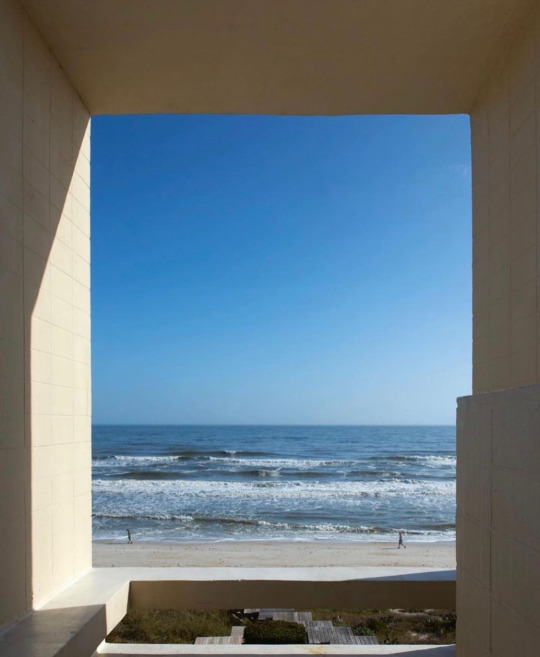
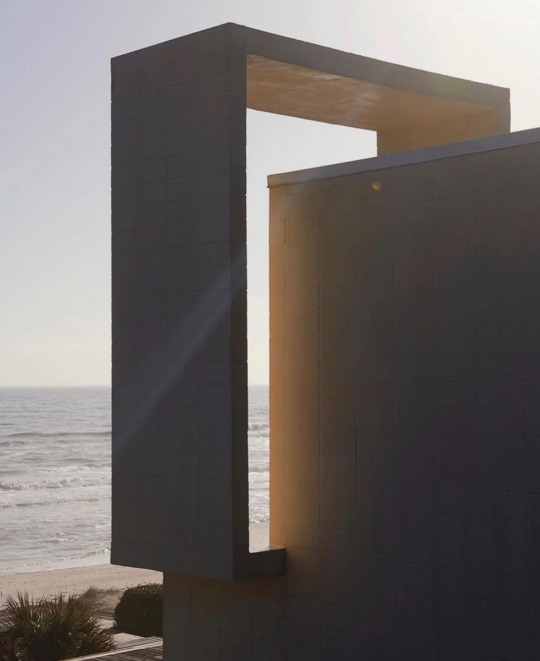

Milam House
Location: Jacksonville, Florida
Year: 1961
Architect: Paul Rudolph
5 notes
·
View notes
Text


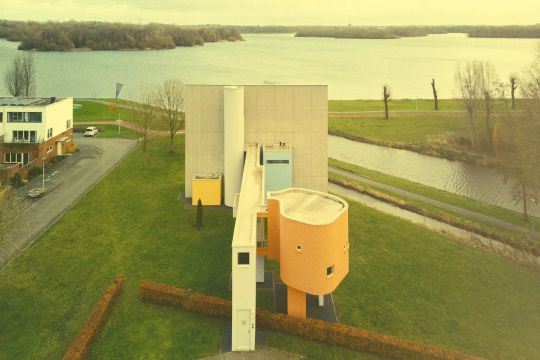
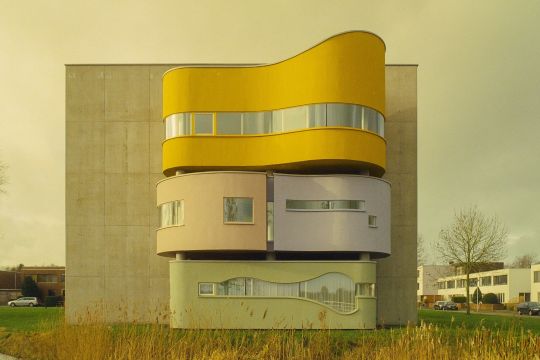

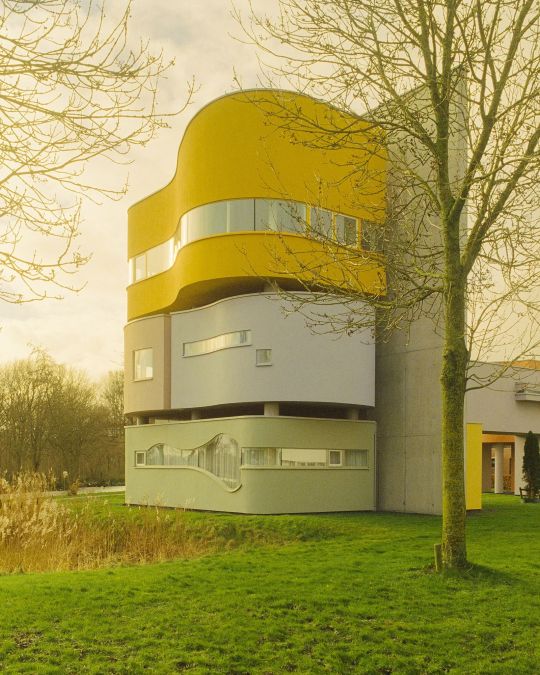
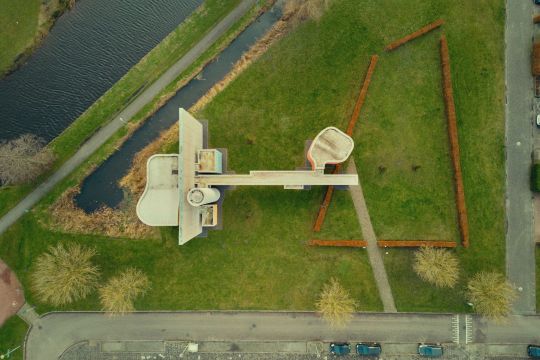
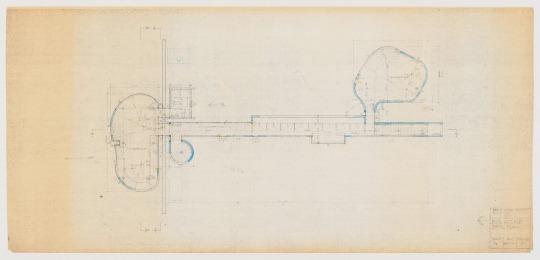
John Hejduk, "Wall House No. 2,"
Hoornse Meer, Groningen, Netherlands,
John Hejduk originally designed Wall House No. 2 in 1973 as a weekend retreat for landscape architect Arthur Edward Bye. The House was to be built in Ridgefield, Connecticut, United States. However, it wasn’t until 2001 that the structure was built as part of the Blue Moon architecture festival in Groningen.
In this project, Hejduk uses the wall to reinterpret the traditional configuration of a house: instead of presenting the different spaces enclosed within the perimeter walls, in the Wall House 2 the rooms and the circulation systems are physically isolated from each other.
The kitchen, dining room, bedroom and living room are stacked curvilinear volumes, vertically linked by an independent circular staircase and connected to a study by a long corridor.
The wall, which Hejduk establishes between the rooms and the circulation systems so that one has to go through it to move from one room to another, becomes a passing line, a limit. A palette of yellow, green, black, brown and gray reinforces the division of the function of each volume.
Since 2004, Wall House has served cultural purposes under the Stichting Wall House Number 2 foundation, hosting artist residencies, public tours, events, and functioning as a knowledge center.
Built by Thomas Muller / van Raimann Architekten and Otonomo Architecten studios,
Photos by David Altrath
John Hejduk (1929-2000), Bye House plan for the second floor, 1974. Yellow and blue coloured pencil and graphite over diazo type on paper, 459 x 980 mm. John Hejduk fonds, Canadian Centre for Architecture © CCA.
#art#design#architecture#photography#john hejduk#wall house#netherlands#landscaping#forms#sculpture#david altrath#arthur edward bye#conceptual#history#cubist#surrealism#stucco
186 notes
·
View notes
Text
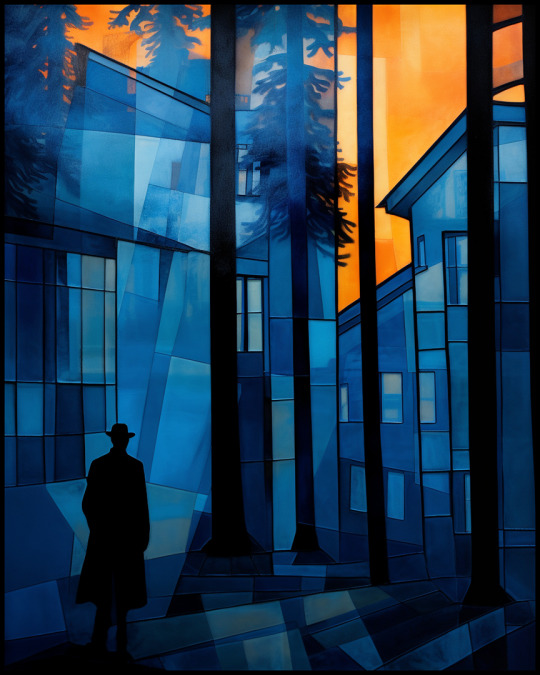
Landscape Blues, Variation 23091 By Jeff Stanford, 2023
Buy prints at: https://jeff-stanford.pixels.com/
#© Jeff Stanford#midjourney#midjourneyart#ai#discord#digitalart#aiart#Artists on tumblr#buildings#blues#pine trees#forest#conifers#blue light#cubist cityscapes#translucent color#azure#fused glass art#light orange#architecture paintings#shadowy stillness#surreal architectural landscapes#stained glass#tonalist paintings#vibrant colors#silhouette lighting#amber
190 notes
·
View notes
Text
if youve ever wanted a very relevant capture of my boyfriends artistic aesthetic you should look up the stop motion film Krysaŕ (the pied piper). I stumbled on it in the library films app today and.... yea.
its also just a wildly impressive work of art, like its largely hand carved wood sculpture and if you have the stomach for cubist surrealism, mice, and a little violence its definitely a recommendation.
#some of the character sculptures literally look like the ceramic masks he made in college#and the weird dull cubist architecture is 10000% his jam
2 notes
·
View notes
Text
I support this product idea on LEGO Ideas, and you should, too!
0 notes
Text






#ai generated#ai image#ai photography#stable diffusion#brutalism#brutalistic#architecture#concrete#cubism#cubistic
1 note
·
View note
Text

#yellow aesthetic#house#architecture#photography#original photography on tumblr#netherlands#rotterdam#cubism#cubist#aesthetic#my photos#holland
0 notes
Text

Cubistic architecture in Prague.
389 notes
·
View notes
Text







Venice in the art of Alexandra Exter (1882-1949)
Carnival in Venice (oil on canvas) 1930s
Carnival Procession (oil on canvas)
Masked Figures by the Banks of a Venetian Canal (oil on canvas)
Venetian Masks (oil on panel)
Pulcinella (gouache on paper) late 1920s-30s
Venice (oil and sand on canvas) 1925
Venice, 1915
"Aleksandra Aleksandrovna Ekster, also known as Alexandra Exter, was a Russian and French painter and designer. As a young woman, her studio in Kiev attracted all the city's creative luminaries, and she became a figure of the Paris salons, mixing with Picasso, Braque and others. She is identified with the Russian/Ukrainian avant-garde, as a Cubo-futurist, Constructivist, and influencer of the Art Deco movement. She was the teacher of several School of Paris artists such as Abraham Mintchine, Isaac Frenkel Frenel and the film directors Grigori Kozintsev, Sergei Yutkevich among others." [x]
"Exter painted views of Florence, Genoa and Rome, but ‘most insistent and frequent were images of Venice. The city emerged in various forms: via the outlines of its buildings, in the ‘witchcraft of water’. In glimmering echoes of Renaissance painting, in costumes and masks and its carnivals’.
"Exter’s characteristic use of the bridge as a stage platform, seen most clearly in Carnival in Venice, is a legacy of her time as Tairov’s chief designer [Alexander Tairrov, director of Moscow's Kamerny Theatre]; the director believed in breaking up the flatness of the stage floor which the artist achieved for him by introducing arches, steps and mirrors. Even in her easel work, the emphasis is at all times on theatricality. Bridges are used as proscenium arches, the architecture creates a stage-like space in which to arrange her cast."
"For all her modernity, references to Venetian art of the past abound in these paintings. The masked figures are influenced by the Venetian artist Pietro Longhi, to whom Exter dedicated a series of works around this time. The incredible blues used in both Carnival Procession and Masked Figures by the Banks of a Venetian Canal are a direct reference to Titian, who was famed for his use of ultramarine, the pigment most associated with Venice’s history as the principal trading port with the East." [x]
"Exter had long since abandoned the Cubist syntax by 1925 but her sense of colour remained together with a strong conviction, shared with Léger, that a work of art should elicit a feeling of mathematical order. In its graceful interaction of fragmented planes and oscillation between emerging and receding elements, Venice (1925) echoes the more precise qualities that also appear in Léger's work at this time, both artists occupied with the continuous modulation of surfaces and the 'melody of construction' that Le Corbusier was still advocating in the 1930s. But while Exter subscribed to Léger's theory that 'a painting in its beauty must be equal to a beautiful industrial production', she never fully embraced the aesthetics of the machine and rejecting the common opposition between ancient and modern, her work often retains a classical edge - for example in these trefoil windows, arches and vaults. Human figures, which had been nearly absent from her Cubo-futurist paintings, also return in other works from this period."
"She was undoubtedly aware of the concept of 'defamiliarisation', a term first coined by the influential literary critic Viktor Shklovsky in 1917:
'The purpose of art is to impart the sensation of things as they are perceived and not as they are known. The technique of art is to make objects 'unfamiliar,' to make forms difficult to increase the difficulty and length of perception because the process of perception is an aesthetic end in itself and must be prolonged.'
An instance of this device is discernable in the present tight formation of the oars, seen from above. Like Braque and Picasso, Exter incorporates sand into certain areas of pigment to enhance the differentiation of surfaces, a technique also used to 'increase the length of perception'. The occasional lack of overlap between the boundaries of the textured surfaces and colour planes strengthens the paradoxical combination of tangible presence and elusive abstraction that makes Venice such a powerful work."
"Venetian subjects occur in Exter's work as early as 1915. A gigantic panneau of the city was one of the final works she produced in the Soviet Union and exhibited in the 1924 Venice Biennale." [x]
"The specific theme of the Commedia dell’Arte first appeared in Exter’s work in 1926 when the Danish film director Urban Gad approached her to design the sets and marionettes for a film which was to tell the story of Pulcinella and Colombina, transposing them from the Venice of Carlo Goldoni to contemporary New York. Pulcinella most likely relates to the artist’s subsequent experimentations on the theme of the Commedia dell’Arte. Pulcinella, who came to be known as Punch in England, is one of the classical characters of the Neapolitan puppetry. Typically depicted wearing a pointed hat and a mask, Pulcinella is an opportunist who always sides with the winner in any situation and fears no consequences." [x]
56 notes
·
View notes
Text


In our latitudes the art of Brazil still leads a somewhat shadowy existence, especially with regard to the decades before the Second World War. With its current exhibition „Brasil! Brasil! The Birth of Modernism“ the Zentrum Paul Klee up until January 5, 2025 attempts to broaden our view on Brazilian modern art and takes a closer look at the origins of its modern art and the artists involved in it. In order to allow for an overview of the different artistic currents as well as the individual developments of the artists, the curators decided to limit the exhibition to 10 artists that represent different strands of Brazilian modern art: Tarsila do Amaral (1886-1973), Anita Malfatti (1889-1964), Lasar Segall (1889-1957), Alfredo Volpi (1896-1988), Vicente do Rego Monteiro (1899-1970), Flávio de Carvalho (1899-1973), Candido Portinari (1903-1962), Djanira da Motta e Silva (1914-1979), Rubem Valentim (1922-1991) and Geraldo de Barros (1923-1998). Gaining independence in 1889 Brazil at the turn of the 20th century was a country on the move, looking to define its identity. Naturally, artists of all trades also sought to define a Brazilian art, stripped off the colonial past and representative of the now independent country, efforts that culminated in the „Semana de Arte Moderna“ in São Paulo in 1922: financed by coffee tycoon Paulo Prado the art week sought to shift the focus from Rio de Janeiro to the economic center of Brazil but also presented a wide array of modern art, architecture and music. Subsequently, Brazilian artists, either financed by their families or on stipends, went to Europe: Anita Malfatti e.g. spent time in Berlin while Tarsila do Amaral, Candido Portinari, Vicente do Rego Monteiro or Geraldo de Barros stayed in Paris. What they brought home were the avant-garde ideas of the expressionists, futurists and cubists which they combined with Brazilian topics and traditions, indigenous and Afro-Brazilian imagery which became an idealized subject in the avant-garde arts.
The reflection of these plural influences can also be traced in the comprehensive catalogue, published by Snoeck, accompanying the exhibition: it contains substantial dossiers of each artist as well as contextualizing essays that paint a complete picture of the Brazilian avant-garde, including literature, architecture and design but also address critical topics like the appropriation of Afra-Indigenous imagery and the central role women played in Brazilian modern art. A very informative, beautifully illustrated catalogue!
29 notes
·
View notes
Text
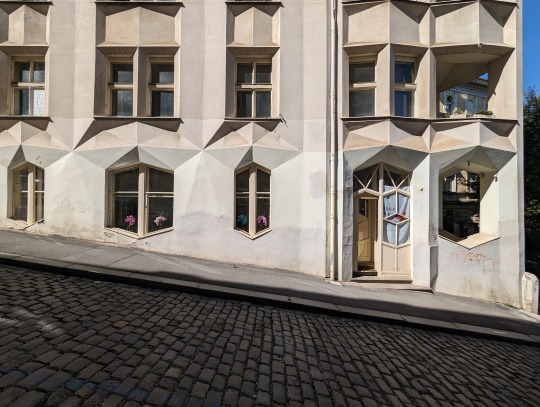
Cubistic architecture in Prague
#prague#cubism#architecture#facade#building#photography#windows#Czech Republic#arquitectura#detalis#detalle#edificios#cubismo
64 notes
·
View notes
Note
Wait wait wait sir sir I got a question
does au Crowley have a nice singing voice.
IMAGINE LIKE. THE POSSIBILITIES. Chat makes him sing a song bc someone donated a very nice amount so he does a little “thank you *name* for this weirdly nice donation” tiny sing song and it’s actually good??? So people try to get Crowley to sing more idk-
HMMM DOES HE?? i try picturing him singing and all i can hear is the apology song SO–
honestly somethin about crowley screams Bad Singer to me. but in a really wonderful, uniquely appealing way. hear me out:
we know he's got this vivid imagination, so i feel like anything he's creatively good at would be in a unique, creative, unorthodox way. like, as an artist, he wouldn't be a realistic renaissance painter, but a push-the-bounds cubist or abstractionist. in architecture, we think of him as brutalist, rather than something with a classic appeal like baroque or even standard minimalism. he's not appealing. but he's revolutionary.
so, with music, he wouldn't sound pretty, can't sing a smooth run or even have an impressive range. but he would have lungs for days and you'd know his voice instantly. i'm talkin cage the elephant, alt j, the vaccines, fucking menomena quality. he doesn't sound pretty but he sounds otherworldly, and he can't sing you to sleep but he'd change whatever genre he tipped his toe in forever.
SOOOO yeah. i think he'd have a shit voice. and it would fucking rock
#also not me literally growing a beard and having he/him pronouns in my bio and still giddy when strangers call me sir#i mean *coughs and lowers voice* 𝓱𝓮𝔂#good omens#ineffable streamers#ask a rat
49 notes
·
View notes
Text
George W. Maher, architect - part 2
My previous post focused on Maher-designed houses on Hutchinson St., now a Chicago historic district. For this post, I spent part of a day photographing some of Maher's other residential work in Chicago.
Stevenson-Colvin House
Address: 5940 N. Sheridan Rd.
Year Built: 1909
Architect: George W. Maher

The Stevenson-Colvin House
The Harry M. Stevenson house at 4950 N. Sheridan Road dates to 1909 and is a rare survivor of the large homes that lined the street in the first decades of the 20th century. The house, referred to today as the Colvin house for its second owner, features a distinctive Maher dormer, second floor windows recessed behind columns, and a motif of tulips and triangles. It has been restored in recent years and now functions as an events venue.
Classic Chicago Magazine
I took the following photos of the Colvin House during a past Open House Chicago weekend, sponsored by the Chicago Architecture Center:







Unfortunately, the interior has been remodeled, removing virtually all of Maher's original design. The chandelier, however, and the stair rail, are original. The house is now an events venue.

Residence of Edwin M. Colvin, Esq., Chicago. The Architectural Record, 1916 Feb., v. 39, p. 175. ill, plans.
J.H. Hoekscher House
4506 N. Sheridan Rd., 1902


4506 N. Sheridan shortly after completion in 1902 (Inland Architect)
Interior photos available here
King / Nash House, 1901-1902
3234 W Washington Blvd., Chicago

This house is an amalgamation of the Sullivanesque, Colonial Revival, and Prairie styles. It was originally commissioned by wealthy businessman Patrick J. King, but its most well-known occupant was the influential Irish-Catholic politician Patrick A. Nash, who lived here from 1925 to 1943, when Washington Boulevard was one of the city's most-fashionable addresses.
Chicago Landmarks
Davey Pate / Charles Comiskey House, 1901
5131 S. Michigan Ave., Chicago


Maher designed this house for Chicago lumberman Davey Pate. The house was later owned by Charles Comiskey, long-time owner of the Chicago White Sox baseball team.
Magerstadt House, 1906-1908
4930 South Greenwood Avenue, Chicago



Completed the same year that Maher was devising a master plan for the Northwestern University campus, the Magerstadt House sits sideways on its deep, narrow lot, with the front door facing what is now the driveway. Visible from the street is a rectangular side porch whose pillars sport carved poppies.
Chicago Magazine
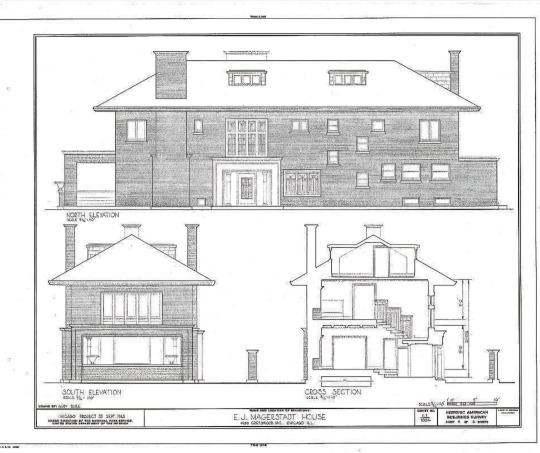
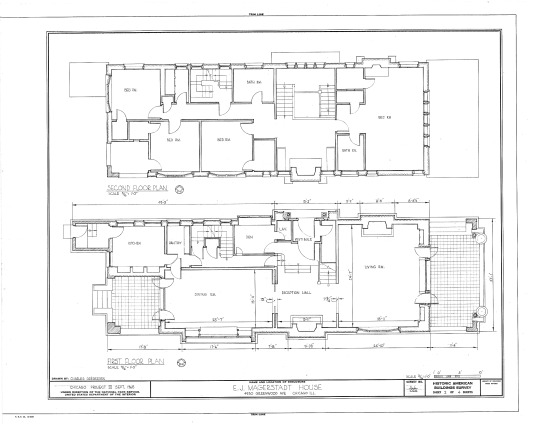
Elevation and plans above and photos below, HABS survey documents
This house is probably one of the finest works of George W. Maher, a contemporary of Frank Lloyd Wright, and one of the Prairie School. It shows a relationship to Wright's work of the time in its cubist massing, ribbons of windows, simple, low-pitched roof, and deep, unbroken eaves. The influence of Art Nouveau is also evident, as is seen in the extensive use of the poppy motif in the ornament and interior finish.
Library of Congress






This photo and other interior views on Redfin
Link: Magerstadt House HABS Report
5 notes
·
View notes
Text




Aida Tomescu (b 1955) Romania, Australia
Spora I (2008) oil on canvas
A Deborah Hart, Senior Curator, National Gallery of Australia
Like blooms that appear quite startlingly before winter’s end, only to be ravaged by frost and wind and then renewed when the season of their being arrives, Aida Tomescu’s works are in a constant state of becoming. Over the years she has developed her own distinctive, continually evolving visual language, working from one group or ensemble of works to the next. Each series, irrespective of media, is like a new beginning; informed by previous experience and yet restlessly, determinedly eschewing the easy, known path in search of new life.
There is a sense of vitality whether it be in the radiance of the paintings or the persistent searching line in the drawings…It is possible to see the ways in which the drawings become increasingly layered, expansive and informed by colour like the paintings and the ways in which the aspect of drawing has increasingly entered into the paintings.
Ultimately what Tomescu’s art has shown us is that it can never be pinned down to one thing, that it is about open-ended associations, moving between the tangible and intangible. It is perhaps in giving up the need for tangible certainties in favour of more subtle intimations that this fluid state of becoming is revealed.
Paul Selwood (b1946)
Sacred Play (2009) steel, varnish
B Bridget Macleod artistprofile.com.au
There are two main theoretical strands to my practice. One is involved with illusory space, re-presenting perspective drawing in the cut-outs. The other deals with real and constructed sculptural space. The two have an historic convergence in the Cubist collage.
I have been doing the perspective cut-outs since the early 1980s. They began on paper as a speculative drawing process towards the possibility of future three-dimensional sculpture. At one point, having arrived at what looked like a good proposition, I decided to cut away the background in order to better visualise what the sculpture would be. I was impressed by the heightened illusion of form resulting from this and decided to do a big one on rusted steel sheet. On the paper, I differentiated the planes with washes and shading of paint. On the steel, I wanted to keep the rust, so I used flat and gloss varnish on opposite planes which considerably enhanced the illusion of the third dimension. Steel is associated with mass and weight, so the works were further enhanced by an illusion of impossible gravity. Heavy architectural forms appear to be floating. The illusion is continued to the wall which becomes space. By extension, the ground the viewer is standing on is called into question.
....I am interested in the psychology of perception. How we focus on an object in a white box in a gallery compared to the same object on the ground when we are standing in the street. Take a screwed-up piece of paper and put it on a white plinth in an art gallery. You are inviting the public to examine all the shapes, folds and nuances of light that there might be. You might be saying is this sculpture? But on the ground, it is only a piece of screwed-up paper.
collection: Orange Regional Gallery, New South Wales
3 notes
·
View notes
Text
Architectural Finds, 06/25/2023
Today's walk was short, I was just going in to DoBro to get some things from target but of course I had to stop and take some pictures along the way. Here are some architectural highlights from the walk there.


First were these row-houses along Fulton St, and this cool corner window aspect that the end house had.
Built 1882.
Located at 664-674 Fulton St, these seemed like they were all the same architect save for the third house in at 668 which looked like it been rebuilt at some point or maybe covered with a brick facade.
You can see some of the rusting from the old Cast-Iron facade that was cutting edge technology in the day in the second picture.
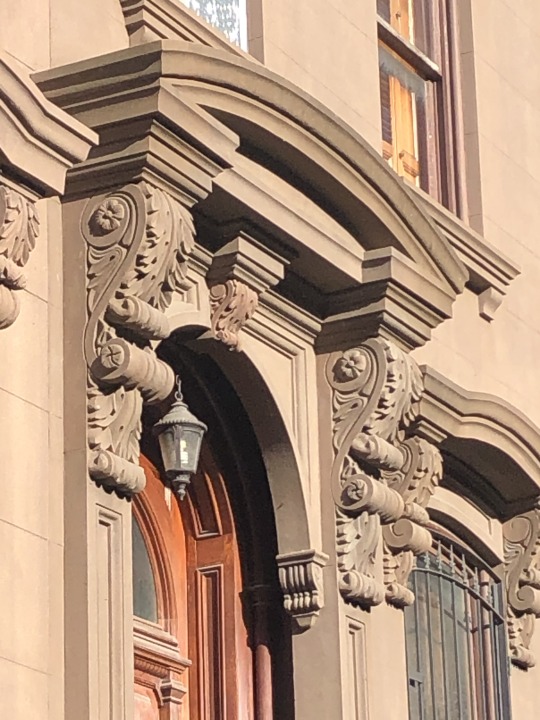

Another row of houses that caught my eye were this row of brownstones with their beautiful ornamentation around the door frames. This is right around the corner at 109-117 S Elliot Pl.
I have no way of knowing if they were all built by the same owners originally as I cant seem to find any records for them online :/, but they were likely built around the turn of the last century 1890-1910 when this style of building was commonly constructed. It was likely that they were built by separate owners/architects, as their ornamental stone decorations aren't all exactly the same.
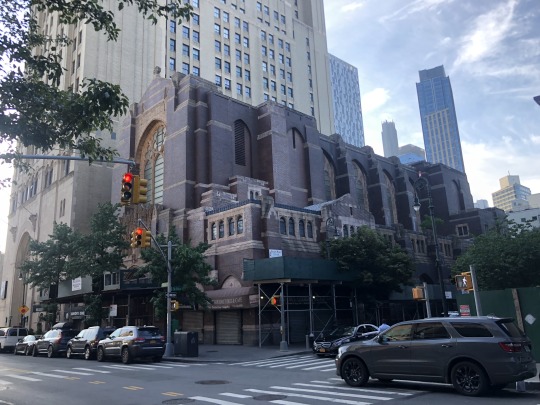
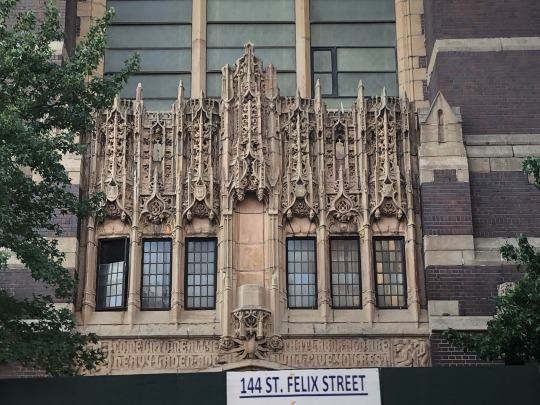
Moving on, A CHURCH! That's right I love a good ornate church and this one surely delivered. Just look at that gothic stone articulation above the entrance! Its so organic looking, it sends shivers down my spine just looking at it and I want to sink my teeth into it all in one.
Built in 1931 to the tune of the Hanson Place Central United Methodist Church, and today it sits abandoned, boarded up, and full of black mold.
The overall shape of the building is so interesting it has so much going on with its MASSIVE brick pillar motifs, likely intended to vertically gesture up toward the creator.
One source describes it as "Gothic restyled in modern dress, an exercise in massing brick and tan terracotta that might be called cubistic Art Moderne."
Someone with more theological architectural background could go further in depth than I can on it I'm sure, but it's always exciting to see the passionate attention to detail that a good cathedral has in it's architecture.
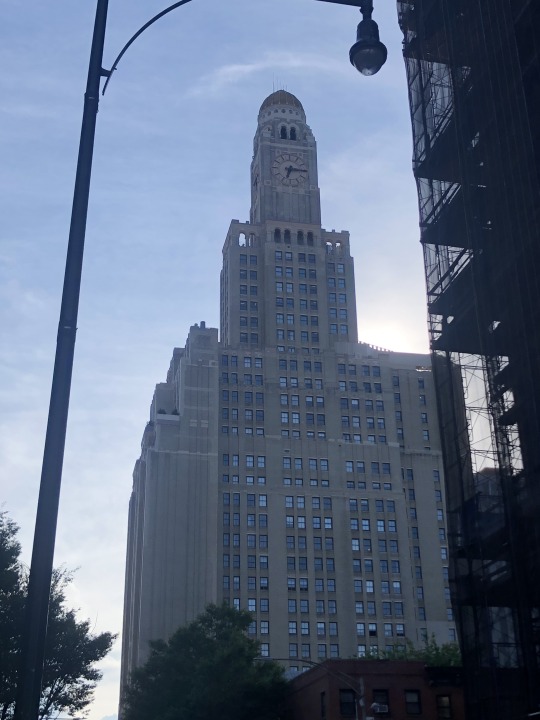

Next I don't know if I love this one but I just wanted to shout it out as having a BIG clock face! Like that thing is so high upppp it must be 100 feet in diameter!
Without even looking it up I'm going to take a shot in the dark and say this is maybe Brooklyn City Hall, or another government building??? It resembles the thing they're doing in all of the governing buildings I've seen up in Albany.
I don't particularly like this architectural style its boring and chunky in my opinion, but I have to say its not the ugliest thing I've seen. I respect the sense of radial symmetry its upper terraces and flanks suggest, and cmon you cant knock that clock.
(update: it's a bank building)

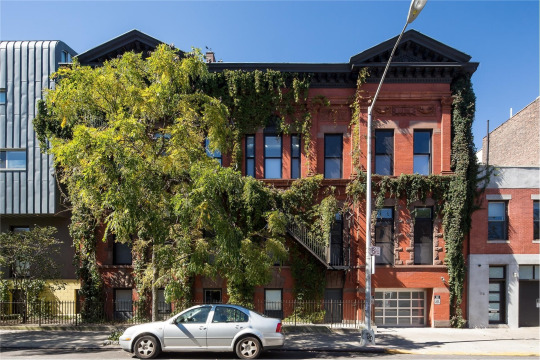
Second to last, we have this red & black beauty. Love the Greek-Revival pediments on each wing of the building as well as the renaissance revival inclusions in the carved cords/ribbons hanging in between the pilasters.
After some research, this seems to be an old Schoolhouse built in 1892 that has unfortunately since been absorbed by the ultra-modern townhouse on the end of the street at 81 Hanson Pl and transformed into a massive painting studio/home by painter David Salle. Wish I could find more info on the original schoolhouse tho :/
(Second photo ripped from google images)
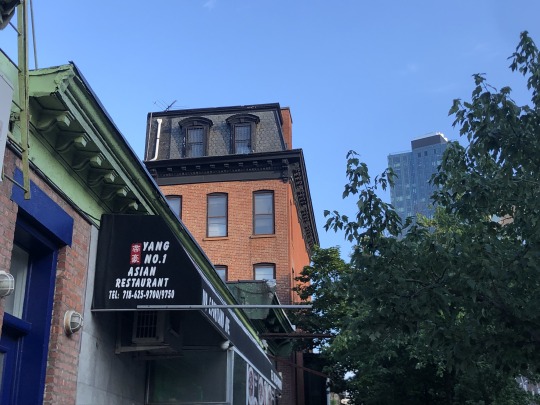
HONORABLE MENTION: Caught this Mansard Roof moment on my way into the subway station and oof, tug at my heartstrings this is cute.
Across the street from the dream studio/abomination this guy sits pretty at 83 Hanson Pl and is the only brownstone on the block with a cute hat (mansard roof).
#Brownstone#DoBro#Boerum#Fort Greene#Brooklyn#architecture#architect#Mansard roof#Schoolhouse#Italianate#greek revival#Renaissance Revival#Romanesque#church architecture#Gothic#art moderne#cast iron#facade#building#Row house#19th Century Architecture
15 notes
·
View notes
Text

Music and Poetry, a Timeless Relationship!
The relationship between music and poetry is so strong that has survived the ages. It has been challenged, questioned, scrutinized but is still alive today to prove that some bonds are hard to break.
While each is an autonomous form of art, music, and poetry work well together. Yes, there's a close connection between many forms of art – dancing, painting, performing, architecture, sculpture. They are all forms of expression. But there's something unique that connects poetry and music, and the interesting part is that it does so for centuries.
Music has been part of all societies around the globe to what it seems to be the beginning of time. It is believed that music was originated in Africa by tribes that used various materials to create what we know today as instruments to produce sounds. It became an essential part of every culture and influenced by it and all aspects of life – religion, climate, economic and social factors, customs. Poetry, as a form of rhythmic language that intends to evoke meaning, was known before written texts and was used to remember laws, family history, events. To remember and not forget, some phrases were repeated. The tone of voice was rhythmic. It is, perhaps, then when poetry and music met. The Greek rhapsodies, the Japanese tanka, the Chinese Shijing are all typical examples of sung poems. Eventually, the forms and genres of poetry broadened and while used for different purposes and were of various lengths, they all included some rhythm – epics, hymns, psalms, elegies, hadiths, suras.
The strong bond between poetry and music is clearer when the two forms of art are seen independently. Each of them can stand alone but also get inspired by the other. It is obvious that there are many forms of music as there are many forms of poetry. And they cannot always co-exist. Take “The Cubist Break-up” by E.E. Cummings, for example. Could it ever have a melody attached to it? Not all poems can blend with music.
Then again, we must make a distinction here. The lyrics of a song can be beautiful enough and structured in such a way as to be considered a poem. But not all lyrics are poems. And so, our main concern is to see how a poem, which was not meant to be sung, blended with music so nicely as to become popular.
That's a very crucial point to the history of the relationship between poetry and music. Poems, which would have gone unnoticed, have been loved by people when they became songs. In Greece, the poem “Arnisi” written by Nobel laureate and one of the biggest Greek poets, Giorgos Seferis, became extremely popular when it was composed by Mikis Theodorakis. It is said that T.S. Eliot wrote “The Wasteland” inspired by Stravinsky's The Rite of Spring. And that Claude Debussy's Prelude a l'Apres-midi d'un faune was inspired by Stephane Mallarme's “Afternoon of a Faun.” And that Maurice Ravel composed the Trois Poemes de Mallarme, based on the poems by Mallarme.
7 notes
·
View notes